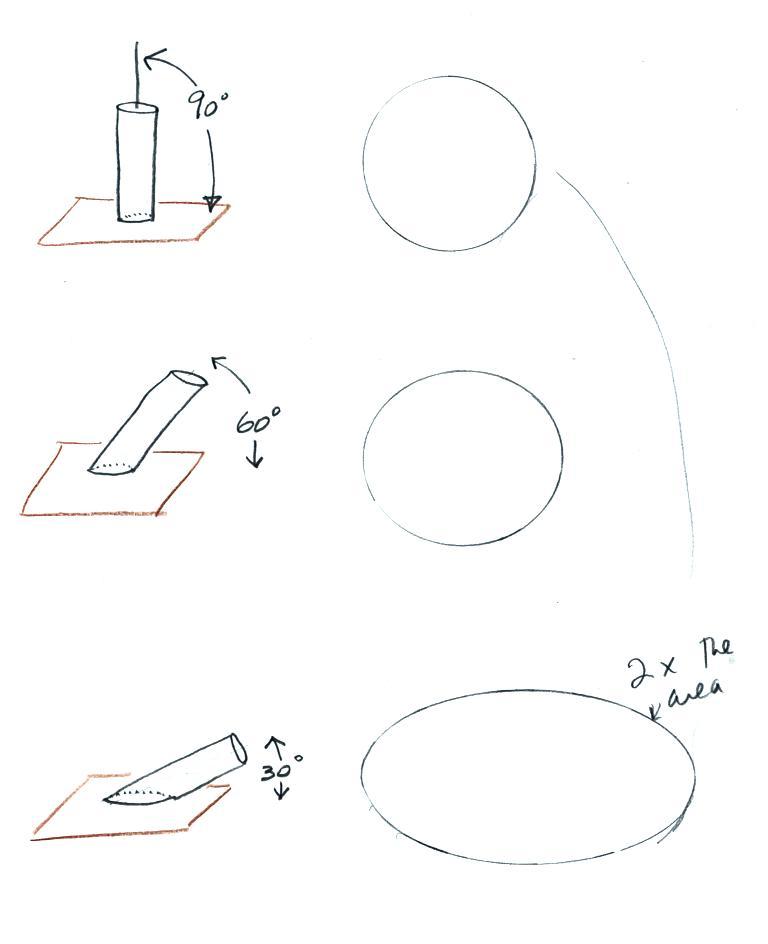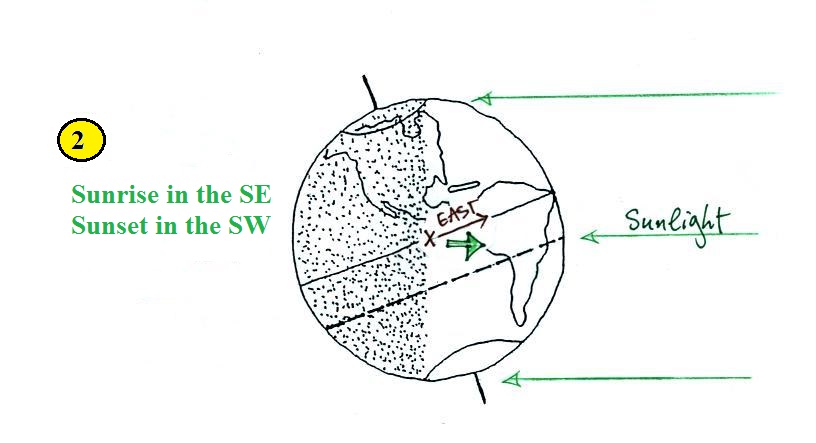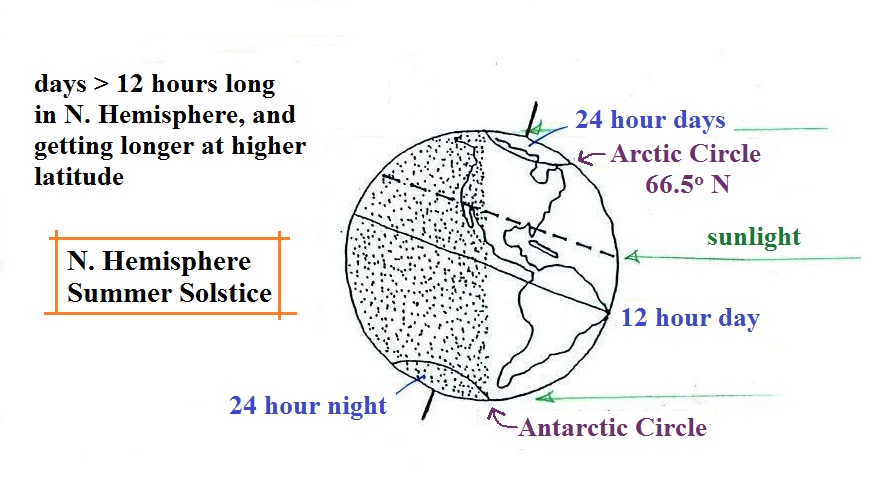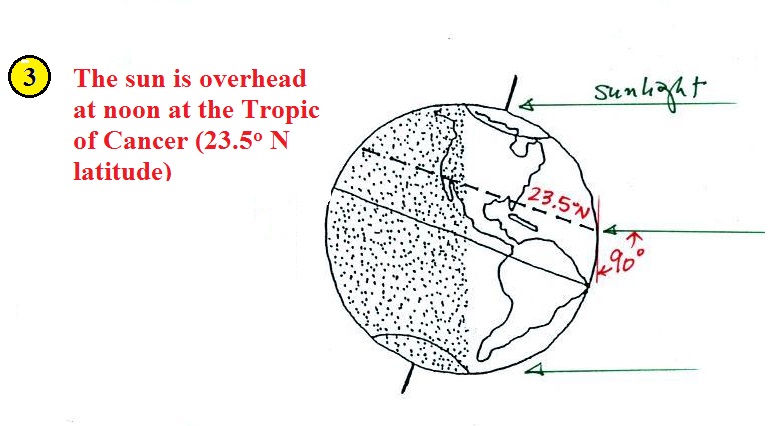Causes
of the Seasons
This section gives a brief explanation of the causes of the
seasons. We'll also list and describe some of the surprising
changes that occur at different locations on the earth during the
year.
First a review of some very basic information concerning the
orbiting earth and its moon. When we cover this material in
class I ask students to fill in the three blanks below (you'll
find this figure on p. 73 in the photocopied ClassNotes).
Many people would have missed the 3rd question and might have said
the moon orbits the earth in about a day. This is because we
see it in about the same position in the sky on successive
nights. The following figure explains what is really
occurring.

The earth's orbit around the sun is elliptical, it's not circular.

Many people know this and think this is the main cause of the
seasons.
The earth is closer to the sun in January than in July (this is
called the perihelion, the point at which the earth is furthest
from the sun is the aphelion). If this were the main cause
of the seasons, summer in Tucson would be in January and winter
would be in July. If you spend the full year in Tucson you
know this is not true. Summer and winter would also both
occur at the same times in both hemispheres. This doesn't
happen either. The changing distance between the earth and
the sun does have an effect but it is not the main cause of
seasonal changes.
The main cause of the seasons is the fact that the earth is tilted
with respect to its orbit around the sun. This is shown in
the next figure.
This figure shows the tilted earth at four locations in its
orbit around the sun. Note how the N. Pole tilts
away from the sun on Dec. 21st and how there are 24 hours of night
north of the Arctic Circle on that date. This is the winter
solstice in the Northern Hemisphere. The N. Pole is tilted
toward the sun on June 21. The sun is in the sky
all 24 hours of the day north of 66.5 N. latitude making this the
summer solstice in the Northern Hemisphere. Try
to imagine what this picture would look like if, instead of
standing at Point A, you moved to the other side of the scene and
looked back toward the sun from Point B.
While seasons on the earth are caused by the changing
orientation of the earth relative to the sun, the figure above
doesn't really explain why this is true.

n the summer when the sun reaches a high elevation angle above
the horizon (at noon), an incoming beam of sunlight will shine
on a relatively small area of ground. The ground will get
hot. The two people sharing the shaft of summer sunlight
will get a sunburn. Shadows at midday are small and it is
hard to find shade.
In the winter the sun is lower in the sky. The same beam of
sunlight gets spread out over a larger area. The energy is
being used to try heat a larger amount of ground. The result
is the the ground won't get as hot. 4 people are able to
share the winter sunlight and won't get burned as quickly.
Notice the longer shadows in the winter picture.
These area differences can be illustrated using three
pieces of PVC pipe. The end of one piece is cut
perpendicularly. The ends of the 2nd and 3rd pieces are cut
at 30o and 60o angles. You simply
trace around the cut end of each piece of pipe on a piece of
paper. Some actual tracings are shown below at right for the
pipe orientations at left.
The end of the 30o pipe covers twice the area
of the 90o pipe. The end of the 60o
pipe is a little larger but not a lot larger than area of the end
of the 90o pipe.
As sunlight passes through the atmosphere it can be absorbed or
reflected. On average (over the globe) about 50% of the
sunlight arriving at the top of the atmosphere actually makes it
to the ground.
A beam of sunlight that travels through the atmosphere at a low
angle (2 of the original 6 rays reach the ground in the right
picture above) is less intense than beam that passes through the
atmosphere more directly (4 of the 6 make it to the ground in the
left picture).
In most locations, the sun is in the sky longer in the summer
than in the winter. In Tucson the days (daylight
hours) are around 14 hours long near the time of the summer
solstice. In the winter the sun only shines for 10 hours on
the winter solstice. Days are 12 hours long on the
equinoxes.
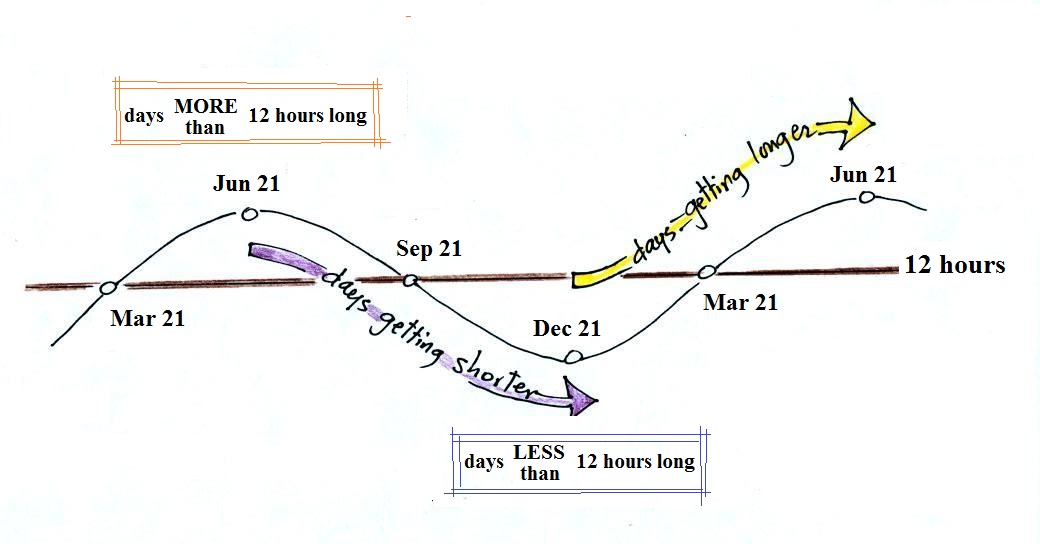
The day to day changes in the length of the
daylight hours is most noticeable (most rapid rate of change)
at the times of the equinoxes.
Sun path diagrams are a way of showing the path that you would
see the sun follow during the day. We'll look at how the
sun's path changes during the course of the year at Tucson, and
we'll also see how the sun's path is different at different
locations on the globe.
The situation is probably the simplest on the equinoxes,
we'll start there (most of the figures that follow are on page 77a in the
ClassNotes)
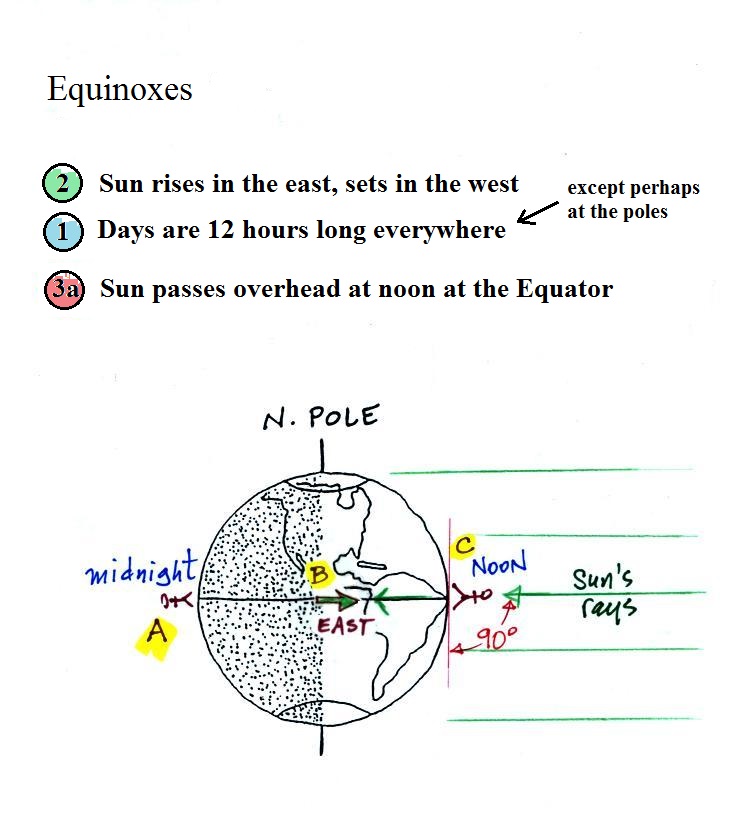
Notice first of all that the line separating day
from night passes through the poles. That is how you know
this is one of the equinoxes and not the summer or winter
solstice.
1.
The line separating day from night passes through the north and
south poles. As the earth spins on its axis, a person
standing anywhere on the globe will spend exactly half the day on
the nighttime side of the picture and half the day on the daytime
side of the picture. Thus the day and night are both 12
hours long. This is true everywhere except at the
poles. We'll see what happens at the poles later.
2.
Imagine standing at the equator. At point A you are
positioned in the middle of the nighttime side of the globe; it is
midnight at Point A. 6 hours later you will be standing at
Point B where you will move from night to day; this is
sunrise. To see the sun you must look exactly back along one
of the rays of light coming from the sun. You must turn and
look straight east to do this. One the equinoxes, the sun
will rise in the east (not just somewhere in the east but exactly
due east). This only happens on the spring and fall
equinox. The rest of the year the sun will rise south or
north of east.
3.
Six hours later you arrive at Point C; it is noon. Now to
see the sun you must tilt your head and look straight
overhead. The sun passes directly overhead at noon at the
equator on the equinoxes.
The picture above shows the earth viewed from outer space.
We will next look at the sun's path in the sky viewed from the
ground where most of us will spend our entire lives.

3.
This
shows
the
path
of
the
sun
at the equator. The sun rises in the east at 6 am, passes
directly overhead at noon, and sets in the west at 6 pm.
4.
The cloud shown next to Point 4 above refers to a band of clouds
that circles the globe at the latitude where the sun passes
overhead at noon. This marks the position of the
"intertropical convergence zone (ITCZ)" (we'll learn more about
the ITCZ later in the semester). You can usually make out
this band of clouds on a full
disk satellite photograph of the earth.
5.
A list of a few cities that are located on or very close to the
equator (Kapingamarangi Atoll will probably also come up later in
the semester)
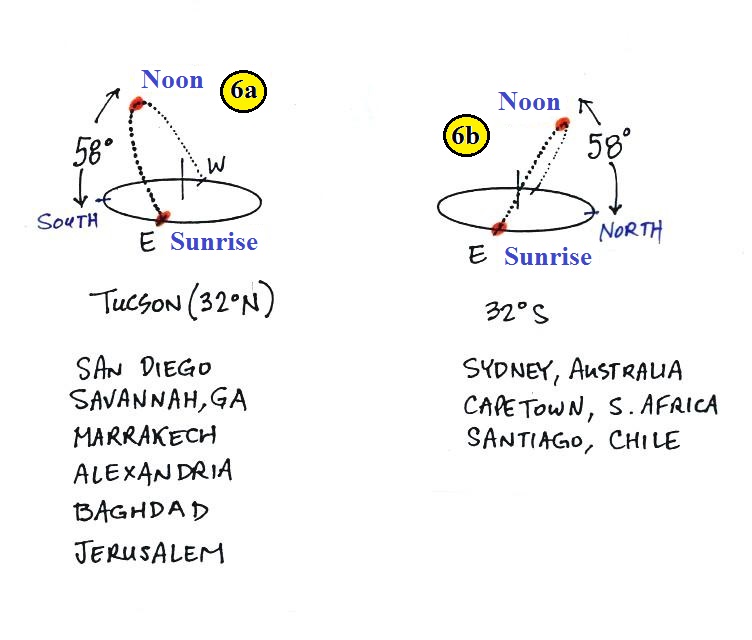
Because the sun rises in the east and sets in the west, crossing
an east-west oriented street near sunrise or sunrise can be
dangerous on or near the equinoxes. The article below is
from the The Arizona Daily Star (the city newspaper) and appeared
near the time of the fall equinox.
In this case the car driver would have had the sun
shining directly in his/her eyes and might really not have seen
the pedestrian crossing the street.
6b.
Sydney Australia is located at 32o
S latitude. In the southern hemisphere the sun rises in the
east, travels into the northern
sky and then sets in the west.
7.
At
Minneapolis
the
sun
rises
in
the east, doesn't get quite as high in the sky at noon (only 45o
above the southern horizon) and sets in the west. Even
though the sun shines for the same amount of time in Minneapolis
as it does in Tucson (12 hours), Minneapolis will receive less
energy during the day because of the lower elevation
angle. Remember that when the sun is low in the sky the
sun's rays must pass through a longer path of atmosphere.
A larger percentage of the sunlight is absorbed and
reflected. Once this attenuated sunlight reaches the
ground it illuminates a larger area on the ground.

8a. At the north pole
the sun really doesn't rise or set. At 6 am you would
find the sun right on the horizon in the east. At noon
it would be positioned in the south. The sun would be
visible at midnight in the north.
8b.
The
sun
also
circles
the
sky
at
the horizon at the south pole. It just travels in the
opposite direction than at the north pole.
Next we'll look at the situation on the Northern Hemisphere winter
solstice. We'll review just the main points. These
winter solstice pictures can be found on page 78a in the
ClassNotes.
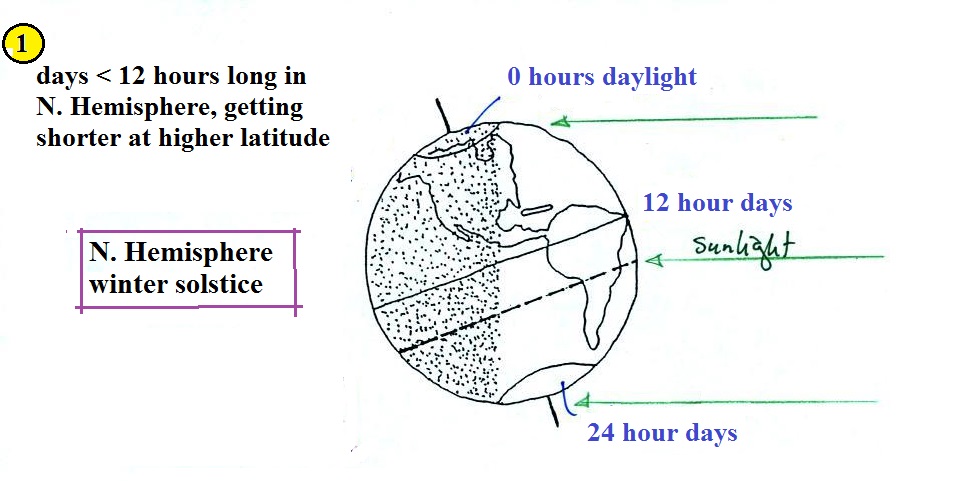
The North Pole is tilted away from the
sun. There are 0 hours of daylight, 24 hours of night
everywhere north of 66.5 N latitude (the Arctic Circle).
There are 24 hours of daylight south 66.5 S latitude (the
Antarctic Circle). The equator is halfway between the
poles, the days are 12 hours long at the equator. Days
are less than 12 hours long in the Northern Hemisphere.
Days get shorter and shorter as you move from the equator to
higher northern latitude.
On the winter solstice you need to turn to the southeast to see
the sun rise. The sun sets in the southwest.
The sun will pass overhead at noon at 23.5 S latitude, at the
Tropic of Capricorn.
Next we will compare the sun's path in the sky in Tucson on the
Winter Solstice (left figure below) and the Equinox (right
figure).
On the equnoxes the days are 12 hours long and the sun rises to
about 60 degrees above the southern horizon at noon. On the
winter solstice the days are shorter, 10 hours long, and the sun
only manages to get about 35 degrees above the horizon at
noon. The two main factors (angle of the sun and number of
daylight hours) that control the amount of sunlight energy
arriving at the ground are working together to reduce the energy
arriving at the ground. This reduction in incoming sunlight
energy is what causes winter in Tucson.
The situation on Dec. 21 in Minneapolis is even "worse". The
days are only 8 hours long and the sun only gets just over 20
degrees above the horizon at noon.
This brings up another important point:
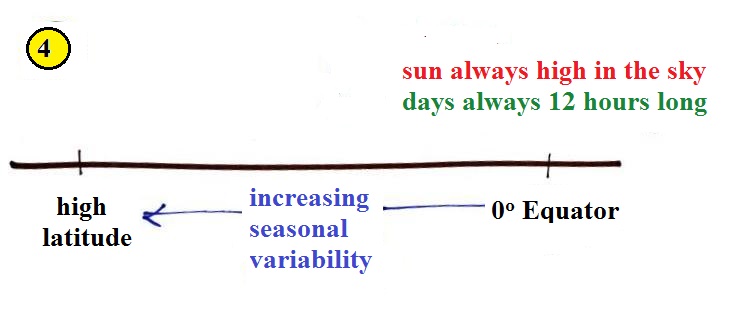
The sun is always pretty high in the sky (at noon) at the equator;
not always overhead but always pretty high (66 degrees or
more). That coupled with the fact that days are 12 hours
long throughout the year means that there is very little seasonal
change in the amount of sunlight energy arriving at the
equator. Seasonal
variability increases as you move away from the equator toward
higher latitude.
We'll
finish with the summer solstice. These figures can be found
on page 79 in the
ClassNotes.
The North Pole is tilted toward the sun. There are 24 hours
of daylight north of the Arctic Circle. There are 0 hours of
daylight (24 hours of night) south of the Antarctic Circle.
At the equator the days are always 12 hours long.
If you look east from position X in the picture you won't see the
sun because you won't be looking back along the ray of light
coming from the sun. You must turn to the north. The
sun rises in the NE on the summer solstice and sets in the NW.
Rays of sunlight strike the globe perpendicularly at 23.5 N
latitude (the Tropic of Cancer) at noon on the summer solstice.
Now the situation in Tucson on the summer solstice compared to the
equinoxes.

On June 21 the sun rises in the NE and sets in the NW. The
sun is 81.5 degrees above the southern horizon at noon, for all
intents and purposes its directly overhead. The days are 14
hours long. There is a lot more sunlight energy arriving at
the ground in summer than on the spring and fall equinoxes.
On the winter solstice we found that the two factors controlling
the amount of sunlight energy arriving at the ground worked
together. As you moved toward higher latitude there was less
and less energy reaching the ground because the days became
shorter and the sun was lower in the sky.
On the summer solstice the two factors don't work together.
If you move from Tucson to Minneapolis, the days become longer but
the sun is lower in the sky. The overall result is less
energy reaching the ground in Minneapolis in a day than in
Tucson. This is examined further in the next figure.
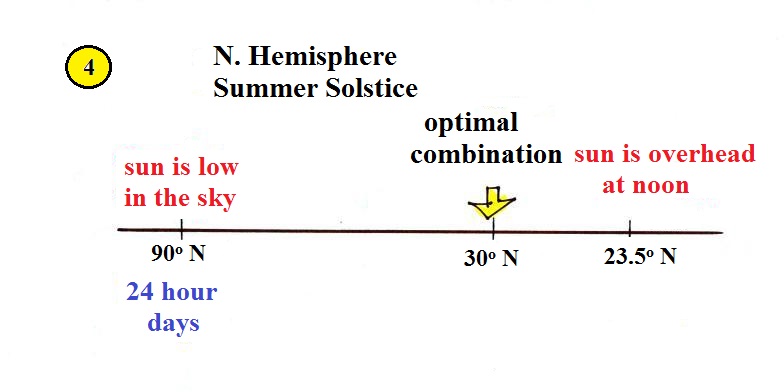
At high latitude the days are long but the sun is low in the
sky. At low latitude (23.5 degrees) the sun is overhead but
the days are shorter (just a little over 12 hours long). At
some point in between these two extremes there must be an optimal
combination of sun angle and number of daylight hours, a
combination that will result in the maximum amount of sunlight
energy arriving at the ground. This "optimum" location is
near 30 degrees latitude. The hottest locations on earth are found near 30
degrees latitude. Tucson is located at 32 N
latitude, that is a big part of why it gets so hot here in the
summer.






